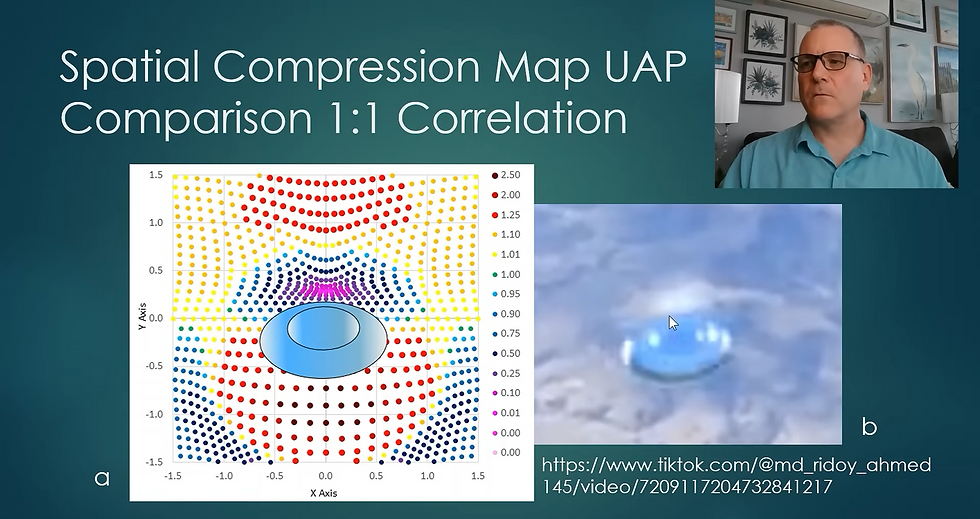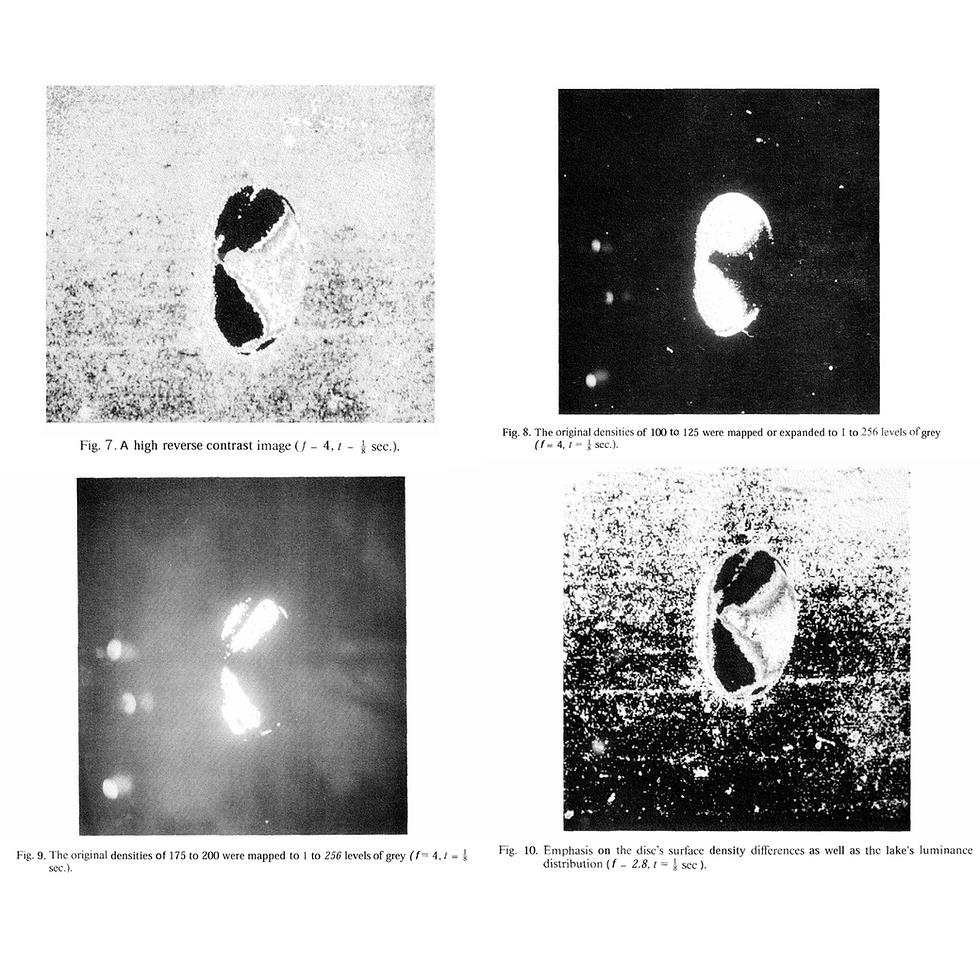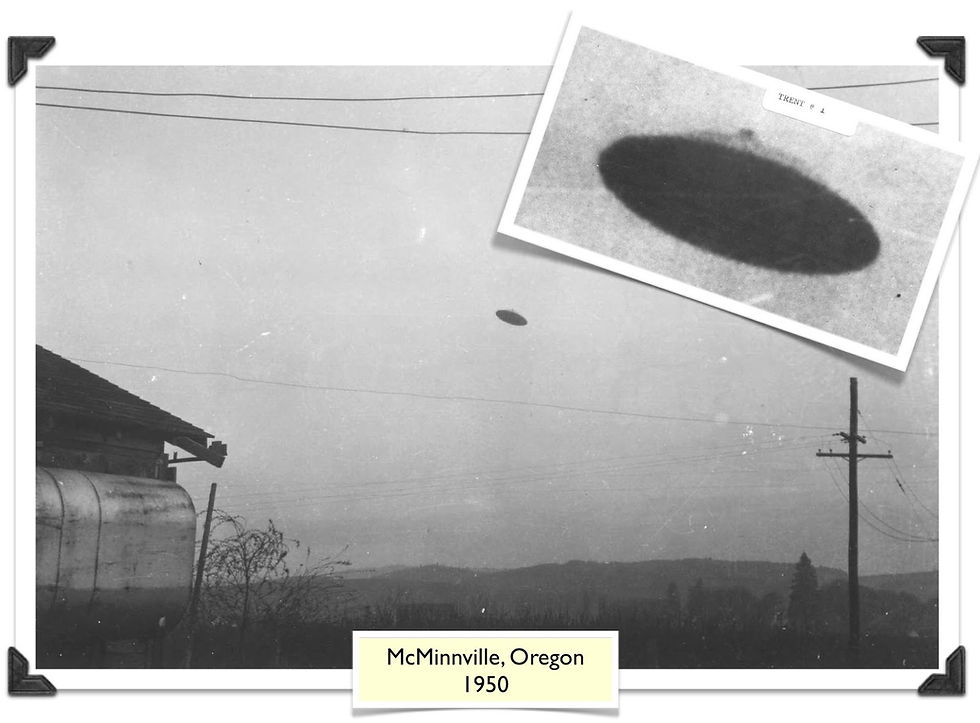Is This the BEST UFO Photo Ever TAKEN?
- Cristina Gomez

- Jun 16
- 9 min read
Updated: Jul 25
What if the most compelling UFO evidence ever recorded was sitting in government archives for decades, captured accidentally by mapping specialists who had no idea they were about to make history? On September 4, 1971, Costa Rican National Geographic Institute workers photographed something extraordinary. Is this the best UFO photo ever taken?
The Routine Mission That Changed Everything
Costa Rica’s National Geographic Institute had a straightforward assignment that September morning in 1971 — conduct aerial mapping surveys for a proposed hydroelectric dam project. The Electricity Institute was funding the survey to identify suitable water sources and land acquisition opportunities for the Arenal dam development. At exactly 8:25 AM, pilot Omar Arias was flying his twin-engine Canadian Aero Commander at 10,000 feet over Lake Cote in northern Costa Rica, accompanied by a professional crew including aerial photography specialist Sergio Loaiza, geographer Juan Bravo, and topographer Francisco Reyes.
French military officials were so convinced by this photograph that they featured it prominently on the cover of their groundbreaking COMETA report in 1999. This wasn’t some fringe publication — it was an official document titled “UFOs and the Department of Defense,” sent directly to the French government by a committee of retired military officials, pilots, and aerospace professionals. Their conclusion was remarkable: the extraterrestrial hypothesis offered the best explanation for the phenomena captured in the Costa Rican photograph.

When The New Yorker profiled UFO researcher Leslie Kean in 2021, they found this exact photograph hanging behind her desk. Kean, who has covered UFOs extensively for The New York Times, called it “the finest image of a UFO ever made public.” She received the photo directly from Costa Rican government contacts, complete with chain-of-custody documentation that traces its provenance from the moment of capture to present day.
September 4th, 1971: The Mission
Costa Rica’s National Geographic Institute had what seemed like a routine assignment that morning — conducting aerial mapping surveys for a proposed hydroelectric dam project. The Electricity Institute was funding the comprehensive survey to identify suitable water sources and land acquisition opportunities for the ambitious Arenal dam development. The mission was purely utilitarian, focused on documenting terrain and water resources with scientific precision.
Loaiza operated sophisticated equipment — an R-M-K 15/23 camera, a 100-pound German-manufactured mapping instrument mounted securely beneath the aircraft. This wasn’t amateur photography equipment; the camera represented cutting-edge cartographic technology of its era. The device used high-resolution black-and-white film with an ASA speed of 80, specifically designed for professional cartographic applications requiring exceptional detail and clarity. An intervalometer automatically captured frames every 20 seconds with mechanical precision, while the camera remained focused at infinity to ensure maximum terrain detail across the entire survey area.
Nobody on board observed anything unusual during the flight. The crew was completely absorbed in their professional duties, methodically documenting the landscape below for the dam project assessment. They were focused on their work, completely unaware that they were about to accidentally capture one of the most significant UFO photographs in history.

The Shocking Discovery
Back in the laboratory, Sergio Loaiza began the meticulous process of developing the film using Kodak Safety aerial stock, type 3665, Grade A — professional-grade materials designed for high-resolution cartographic work. Even after the initial development phase, nothing seemed unusual or out of place. The discovery came later, during the painstaking process of enlarging and examining each individual negative for detailed mapping analysis.
Frame 300 stopped Loaiza completely in his tracks. A massive metallic disc dominated the image with startling clarity and definition that defied easy explanation. The object appeared absolutely nowhere in the preceding frame 299 or the subsequent frame 301, meaning it was captured during that precise 20-second window when the intervalometer triggered. The object had appeared and disappeared within that exact timeframe, creating a photographic record of something extraordinary.

This photograph possesses several unique characteristics that distinguish it from typical UFO imagery. First, it captures an enormous seven-mile by seven-mile area in perfect focus, allowing viewers to discern individual trees, roads, and some researchers claim even livestock in the original high-resolution print. Second, unlike typical UFO photographs shot upward into bright skies where atmospheric interference and lighting conditions often compromise image quality, this photograph looks down from above, providing ideal contrast against the uniform dark surface of Lake Cote. Third, the fixed altitude of the aircraft allowed researchers to make precise size calculations with mathematical certainty.
Leslie Kean explains the photograph’s unique significance: “You clearly see sunlight reflecting off this round object with a small dot on top. This was taken from a government mapping plane with professional equipment. There’s an unbroken chain of custody — it’s remained in Costa Rican government possession since 1971. You know it’s authentic, and it’s completely unexplained.”
Why Is It So Clear?
The exceptional clarity of the Lake Cote photograph raises immediate questions for many UFO researchers and skeptics alike. The common assumption suggests that clear UFO photos must be fabricated, while blurry images somehow carry more authenticity. However, recent analysis by aerospace engineers provides a compelling explanation for this photograph’s remarkable clarity that actually supports its authenticity rather than undermining it.
According to Chad Wanless and Professor Dave Palachik who specialize in analyzing UFO imagery and distinguishing authentic footage from CGI and AI productions, the aerial perspective offers a crucial advantage. Their research suggests that UFO propulsion systems operate primarily below the craft, creating distortion fields and energy effects that significantly impact ground-based photography when cameras look upward. These distortion effects, possibly related to exotic propulsion technologies, can blur or distort images captured from below the craft.

However, when photographing from above, as occurred during the Costa Rican mapping mission, cameras avoid these problematic distortion zones entirely. The lack of energy distortion above the craft allows for crystal-clear image capture, explaining why this aerial photograph achieved such exceptional clarity compared to typical ground-based UFO documentation. The object’s position over water also eliminated potential background distortions that might occur over complex terrain, creating optimal conditions for clear documentation.
The Investigation Begins
The Costa Rican government’s response was swift and decisive — they immediately imposed a comprehensive gag order on the discovery. Sergio Loaiza later recalled the atmosphere of secrecy: “We were completely banned from talking about it. We could not tell anyone.” The photograph became classified material, hidden from public view while government officials grappled with its implications.
The negative eventually reached Ricardo Vilchez, who operated a civilian UFO research group in San Jose, Costa Rica. In 1980, nearly a decade after the original incident, Vilchez conducted comprehensive interviews with Loaiza and meticulously documented the complete story surrounding the photograph’s capture. During these detailed sessions, Loaiza maintained that the specialized mapping equipment was so sensitive and precisely calibrated that even microscopic dust particles would have prevented proper operation. “There was no possibility of error,” he stated emphatically. “There was no trick.”

Vilchez recognized the photograph’s potential significance and forwarded copies to Ground Saucer Watch in the United States, where William Spaulding conducted early computer enhancement analysis and deemed the image legitimate. The case gained serious scientific attention in 1985 when renowned UFO researcher Dr. Jacques Vallée visited Costa Rica specifically to investigate the photograph. Vallée obtained high-quality negative copies and shared them with contacts in both government agencies and private sector technology companies.
When initial analyses proved inconclusive due to resource limitations and lack of dedicated funding, Vallée brought the photograph to Dr. Richard Haines in December 1987. Haines, a retired NASA aerospace engineer with extensive experience in photographic analysis, conducted the most thorough and comprehensive examination to date. He digitized the image, created multiple enlargements, and analyzed every detail with scientific rigor, focusing initially on lighting patterns and optical characteristics.
Scientific Analysis and Findings
Dr. Haines’ analysis revealed fascinating details about the object’s physical characteristics. He observed that the disc displayed “lightness and darkness shading typical of a three-dimensional object illuminated by collimated light such as the sun.” The object appeared to have a cone-shaped profile with perfect symmetry and a distinctly darker apex region. One edge of the disc showed razor-sharp focus while the opposite side appeared diffuse and somewhat irregular. Most intriguingly, Haines suggested that the darker region might not represent a shadow at all, but that the lighter areas might actually be emitting their own illumination.

Computer enhancement revealed additional anomalous features, including what appeared to be surface markings and density variations that suggested complex three-dimensional structure. The analysis showed no evidence of photographic manipulation, double exposure, or other conventional explanations for the image. The film grain around the object appeared completely normal, ruling out various forms of photographic trickery that might have been available in 1971.
Scientific Publication
In 1989, Vallée and Haines published their comprehensive findings in the Journal of Scientific Exploration, a peer-reviewed publication dedicated to examining anomalous phenomena with scientific rigor. Their detailed 19-page analysis represented one of the most thorough scientific examinations of UFO photographic evidence ever conducted. The researchers concluded: “Our research indicates an unidentified, opaque aerial object was photographed at a maximum distance of 10,000 feet. There are no visible propulsion systems and no surface markings except darker regions that appear deliberately arranged. This case must remain open pending additional information.”

Size estimates varied between different analytical laboratories, but all calculations pointed to an enormous object. the peer reviewed paper calculated the disc at nearly 683 feet in diameter. The size calculations were based on precise trigonometric analysis using the known altitude of the aircraft and the measured dimensions of the image on the negative.
The photograph underwent additional analysis in France, where researchers conducted independent examinations that supported the Costa Rican findings. This international scientific validation contributed to the image earning its prominent placement on the cover of France’s official COMETA report, lending governmental credibility to the phenomenon.
Local Legends and Additional Context
The Lake Cote area provides additional context that supports the photograph’s authenticity. Local residents have long reported unusual objects emerging from and submerging into the lake’s waters, creating a pattern of sightings that spans decades. These reports, while anecdotal, suggest that the 1971 photograph may have captured an ongoing phenomenon rather than an isolated incident.
Significantly, neither the frame preceding nor following frame 300 shows any evidence of the craft or water disturbance that might indicate its arrival or departure. This absence of transitional evidence means the object’s origin and destination remain completely unknown. The lack of visible water disturbance also rules out conventional explanations involving watercraft or submarines that might have created similar photographic effects.
The original negative remains secured in Costa Rica’s National Archives, maintained as part of the country’s official historical record. Research copies continue to be available to qualified investigators and scientists like Vallée and Haines, ensuring that the photographic evidence remains accessible for ongoing analysis while preserving the original material.
Connections to Historical UFO Cases
The shape captured in the Lake Cote photograph bears striking resemblance to other famous UFO cases, particularly the McMinnville photographs taken over two decades earlier. On May 11, 1950, in McMinnville, Oregon, Paul and Evelyn Trent captured two black-and-white photographs of a metallic, disc-shaped object hovering silently over their farm. The McMinnville object was estimated at 20–30 feet in diameter and photographed with a simple Kodak camera before being published in Life magazine and gaining widespread public attention.

The McMinnville object represents a classic “flying saucer” design that closely resembles the Lake Cote disc’s metallic form with a slightly domed top. Both objects lack visible propulsion systems or surface markings, sharing remarkably similar profiles that suggest possible consistency in UFO design across different time periods and geographic locations. However, while the McMinnville images were clear for their era and showed the object against a sky background, the Costa Rican photograph benefited from professional mapping equipment and official government context compared to McMinnville’s reliance on civilian testimony.
The McMinnville case was examined by investigators like William Hartmann for the 1969 Condon Report, who deemed the Trents’ account credible despite being unable to provide definitive explanation. Skeptics have suggested the McMinnville photos could represent an elaborate hoax involving a suspended model, but such explanations become far more difficult to apply to the Costa Rican case. Lake Cote’s governmental provenance, professional equipment, and documented chain of custody provide significantly stronger authentication than civilian cases, despite McMinnville’s greater public exposure and historical significance in UFO photography.
Modern Relevance and Ongoing Mystery
More than five decades after its capture, the Lake Cote photograph continues to resist conventional explanation. Unlike many UFO cases that weaken under scrutiny, this image has actually strengthened with time as analysis techniques have improved and alternative explanations have been systematically ruled out. The photograph serves as a benchmark for authentic UFO documentation, demonstrating what genuine evidence might look like when captured under optimal conditions with professional equipment.
The case addresses frequent criticisms about the lack of clear UFO photography in an age of ubiquitous cameras. While countless images may exist in classified government archives worldwide, the Lake Cote photograph represents what happens when such evidence actually reaches public view. Its clarity, provenance, and scientific analysis provide a template for evaluating other UFO imagery and understanding why most public UFO photos fail to meet similar standards of evidence.
The Lake Cote case stands as perhaps the most credible piece of UFO photographic evidence ever made publicly available, continuing to challenge our understanding of aerial phenomena and demanding serious scientific consideration of possibilities that extend beyond















Comments